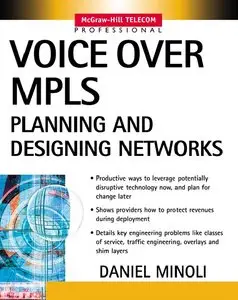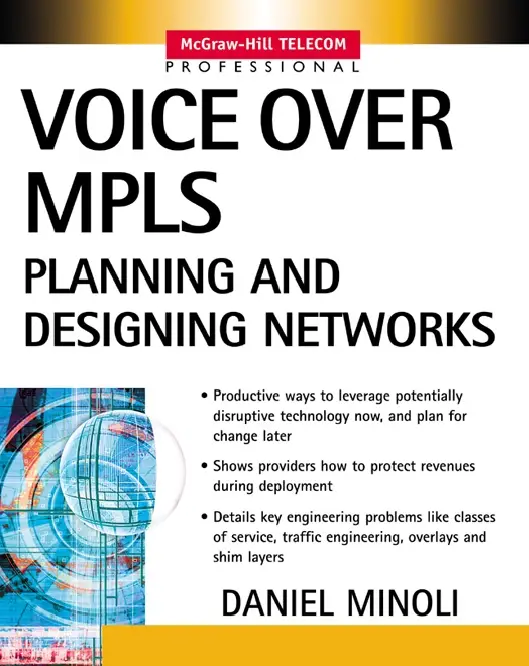Daniel Minoli - Voice Over Mpls: Planning and Designing Networks
McGraw-Hill Companies | 2002 | ISBN: 0071410341 | Pages: 468 | PDF | 2.38 MB
McGraw-Hill Companies | 2002 | ISBN: 0071410341 | Pages: 468 | PDF | 2.38 MB
There has been considerable interest in technologies, systems, and architecturesThanks to original uploader!
supporting voice over packet (VoP) applications during the past
five years. In particular, voice over IP (VoIP) has received tremendous
attention. Although progress on the carrier side has been relatively slow,
particularly in North America, VoIP applications in enterprise networks
have seen a fair degree of success. On the other hand, new-generation carriers
deploying systems in Asia and Europe (including cellular networks)
have found the technology to be cost-effective in greenfield environments.
Setting aside temporarily the discussion on whether VoP/VoIP is a
problem in search of a solution or a solution in search of a problem, two
factors have held back the deployment of VoP/VoIP at the technical level
on a broad scale: quality of service (QoS) considerations and robust signaling
in support of interworking with the embedded Public Switched
Telephone Network (PSTN), which is not going to go away any time in the
foreseeable decade or two.
QoS is where multiprotocol label switching (MPLS) can find its sweet
spot in supporting voice applications. The improved traffic management,
the QoS capabilities, and the efficient packet forwarding via the label
mechanism can be significant advantages to voice.
This topic is a new concept that has little prior literature and advocacy.
This book takes an early look at this promising application. Chapter 1,
“Motivations, Developments, and Opportunities in Voice over Packet (VoP)
Technologies,” explores the motivations, developments, and opportunities
in VoP technologies in general. Chapter 2, “Technologies for Packet-Based
Voice Applications,” looks at voice technologies and requirements. Chapter
3, “Quality of Service (QoS),” surveys the QoS approaches that are
available for connectionless packet services. Chapter 4, “Features of
MPLS,” discusses the features and capabilities of MPLS in some detail.
Chapter 5, “Motivations, Drivers, Approaches, and Advantages of
VoMPLS,” looks at the motivations, drivers, approaches, and advantages
of voice over MPLS (VoMPLS). Chapter 6, “MPLS Forum VoMPLS—
Bearer Transport Implementation Agreement,” looks at MPLS Forum
specifications. Chapter 7, “Signaling Issues for Voice over MPLS,” explores
important signaling issues for VoMPLS. Chapter 8, “Public Network
Issues for VoMPLS and Applications Beyond Transport,” takes a look at
public network issues for VoMPLS and the critical issue of making money
with VoMPLS by addressing applications beyond transport.
Do you know only a small part of all books is visible on the AvaxHome Homepage (@ Home)?
To see all of them use eBooks category.
If you enjoy my books look at my
To see all of them use eBooks category.
If you enjoy my books look at my
…::No mirrors, please::…
Dear users,
There is a growing number of phishing/spoofing rapidshare-similar mirrors in comments. Using it you run the risk of your rapidshare account being STOLEN.
Check them carefully before using, a proper RapidShare mirror has the following format:
http://rapidshare.com/files/xxxDIGITSxxx/File_name
e.g.
http://rapidshare.com/files/198185976/o29.rar
A spoofing link is different e.g.
http://www.rapidshare-com-files-543928-rar.tk
http://rapidshare-com-1141243-rar.h7v.ne
http://rapidshare-com-1411243-pdf-rar.tk
http://rapidshare-com-365289-rar.biz.ci
http://shortman.co.cc/tt
etc…
!!!NEVER EVER USE IT!!!
If you see such links, send a PM to staff immediately (nicks of the staff are here).
***Detailed information about Phishing can be found here***
There is a growing number of phishing/spoofing rapidshare-similar mirrors in comments. Using it you run the risk of your rapidshare account being STOLEN.
Check them carefully before using, a proper RapidShare mirror has the following format:
http://rapidshare.com/files/xxxDIGITSxxx/File_name
e.g.
http://rapidshare.com/files/198185976/o29.rar
A spoofing link is different e.g.
http://www.rapidshare-com-files-543928-rar.tk
http://rapidshare-com-1141243-rar.h7v.ne
http://rapidshare-com-1411243-pdf-rar.tk
http://rapidshare-com-365289-rar.biz.ci
http://shortman.co.cc/tt
etc…
!!!NEVER EVER USE IT!!!
If you see such links, send a PM to staff immediately (nicks of the staff are here).
***Detailed information about Phishing can be found here***





